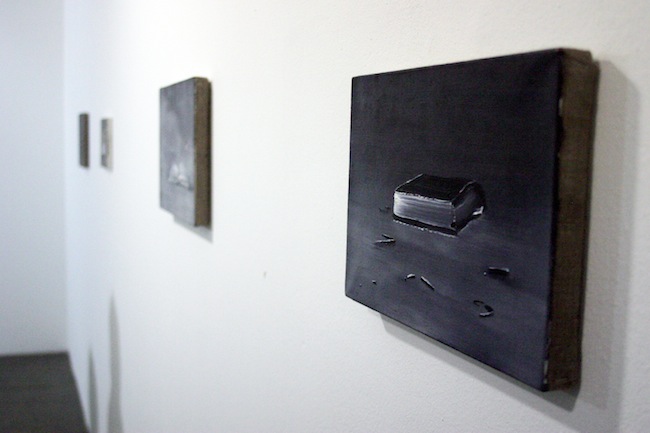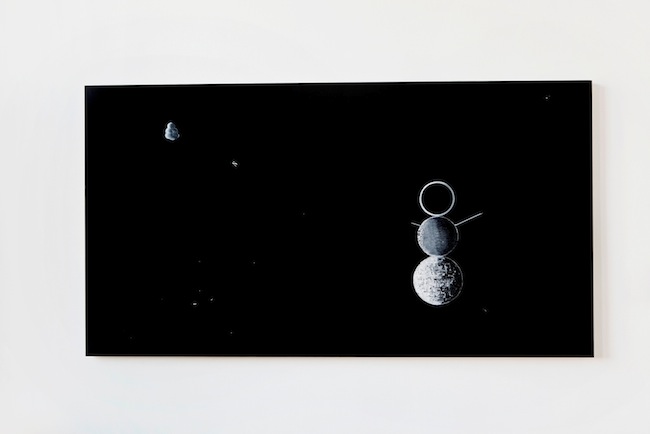
The Serious Snowman
Viestarts Gailītis
07/02/2013
Somewhat strangely, it has turned out that this interview with Ēriks Apaļais is a sort of continuation of my last (however, unpublished) interview with the painter Jānis Avotiņš. It was precisely the name of Apaļais that stuck in my mind after having met with Avotiņš because Avotiņš had pointed out his colleague as being an artist who “works a great deal with the autobiographical, with self-analysis”, as well as one of the few artists with a Western education. In addition, Apaļais' work, like that of Avotiņš', has achieved notice outside of Latvia. Avotiņš may have ended up requesting that his interview not be published, but Ēriks Apaļais (1981) – who currently has a solo show, “Vārdi / Words” on view at the kim? Contemporary Art Centre – politely agreed to an interview, with the condition that it be conducted via e-mail. This had the inadvertent effect of amplifying my sense of a sort of chasm, or a wariness, between social discourse in Latvia and, if I may say so, the creative minds of those with a Western world view.
Why was your essay, Desire for Word in Autobiography, written in English?
I wrote the text while preparing for an exhibition at the Art Cologne art fair (where I participated in the New Positions program), and since I've studied English philology, I wrote the essay in English. In this case, with the exhibition being in Riga, I would have translated the text myself, but since that's a time consuming process, we decided to have a professional translator do it.
Where does the urge to explain your paintings come from?
I think that every artist must be able to speak about his works. In some way, it is a drawing of boundaries around the space of discourse – in which of the genres I am working, and what sort of problems I am solving. If, for instance, an artist paints from photographs, then he must know what the tradition of photographic painting consists of. If an artists works with brushstrokes and dabs, he must know the history of this manner of painting. If I paint autobiographically, then this theoretical knowledge is fundamentally important. But that's the same, old interesting problem – should the artist speak about his works, or should the works speak for themselves?
Lately, I have noticed a trend of Latvian artists joining in on Western discourse. I, too, once studied abroad, and as a student, I allowed myself this fascination. But at the same time, my feelings are divided. On the one hand, these cerebral thoughts captivate, but at the same time, I sense contradiction in the fact of individual philosophers and their hypotheses being so widely reiterated that as a result, a sort of “department store of philosophy” has formed. Doesn't this sort of “unification of thinking” confuse you?
In my opinion, the West is more of a thinking culture, whereas we, Latvians, are more attuned to the mythological world – and there are many cultural-historical reasons for that. This can be confusing because it's a collision of various world views. My explanation is that it is no longer possible to return to nature. The culture of the mind has huge power capital. The issue is whether the mind is being used for good deeds, or for personal gain. I've often seen Western intellectuals arguing about some subject, and from the sidelines, you can see that the argument is actually a game about power.
The most important question is – how should a person live so that we don't harm each other. And every individual should start with himself. This is a complex thing to do within capitalism, but it should never be forgotten.
I also sensed something similar to a “department store of philosophy” when studying in Hamburg. For instance, in a lecture that Hans Ulrich Obrist gave, I didn't hear anything except references – a kind of juggling of quotes and the names of famous artists. The more academically-minded Benjamin Bulcholh noticeably criticized Obrist for this. Now that was true conflict there.
I hope that your allusion to a “department store of philosophy” wasn't aimed at my text. Did it seem to you that the references weren't relative to my work, and that I hadn't fully comprehended them?
You write that “the problem arises when we realize that a successful expression of our wants consists of not only openness, but in a certain amount, also of the enjoyment received from creating our character in front of the reader.” In your opinion, what sort of character are you creating for your audience with this essay?
The purpose of this text is to speak to people and to share in the knowledge that it truly is possible to realize how often we create false notions about the people around us, or about some personal experience, and that it is possible to empty these old notions and fill them with new and positive meaning. I wish for people to take seriously what it is that I want to say, because until it has been theoretically substantiated, they say it is naïve to paint a snowman or a mushroom. I can only imagine what sort of character I create in the eyes of the reader; in reading the comments, it does get quite depressing – they are often brutally aggressive.
Why did you specifically choose Augustine, Rousseau and Sartre when writing about the autobiographical? Why not, for instance, the geographically (and, perhaps, also psychologically) closer Søren Kierkegaard, who also wrote autobiographically and covered subjectivity quite decently? Or Fichte, the founder of romanticism, who was also interested in issues of self-exploration?

In literary criticism, it is precisely these authors who are looked upon as the central figures of the autobiographical genre; I also read Montaigne's Essays, and Descartes' “Discourse on the Method”, which are also autobiographical pieces. I think that these three authors are personally close to me because of Augustine's conversion from doubt to faith, because Rousseau is the emotional and Nature, and because Sartre has that, which is called existential angst. In a sense, very different authors, but I think that mostly people talk about the same thing.
No one has actually said anything new. Plato said that there is idea and form, and linguists say that there is a subject and a descriptor; the contexts are different – the Divine, and language – but there are important parallels that continually rearrange themselves and that maintain similarities.
You write: “Namely, I use painting as a way of writing – in which the demanding mythological desire is grasped and transformed while being cognizant of language's structural character”. When and how did you come to this awareness?
I think that this is linked to life itself, to the inner processes of the soul. I came to this awareness when I could no longer do anything the way it should be done – so that it would be right. And when I broke down, it freed me for something new. I became aware of the old mythological concepts and how they were constructed, and through my works, I try to reveal the structures of these concepts. It's not just about the snowman. The snowman is one of the characters into which additional meanings have been projected.
In your essay you state the logical, sometimes even the self-evident, and many painters would agree with your motivation during painting. But at times, you channel your experience through others (namely, Rousseau, Augustine and Sartre) and you speak academically. As a result, obscurities arise. What, for example, does “the etymology of desire” mean? And why such a complex sentence?: “How can we follow the etymology of desire, and how can we know that this form of the word, with which to express in an autobiographical text the desire for an inner message in a form available for explication, is the most suitable of the descriptors offered up by the culture in question?”
I think that these authors have formed me as a person. If art cannot influence large political processes, then art can most assuredly influence the lives of individual people. For instance, by reading the works of Dostoyevsky, or by watching a film by Bergman, I have changed as a person. That's why I've referenced these authors – to indicate influences. In the second half of the text I write that these influences, which are not connected to painting, I use in my painting nevertheless. I'm guessing that the second part is much more interesting to the reader, because that is where the description of my work begins. The first part creates the context of the background for what it is that I do. In my next essay, I'm thinking of writing specifically about painterly influences and discourses. Cy Twombly is interesting – in terms of thinking about the poetically mythological and about the boundary between painting and writing.
In terms of etymology, I was thinking about something like the root – the source. In terms of the complexity of the sentence, I'll mention that my friends have also often commented that it is difficult to grasp the meaning of my sentences when they are first read. I think that that can be explained by my attempt to condense, that is, to get as much meaning and information as possible into one word. A similar thing happens when painting. The inside of one brushstroke contains judgments that have been made and that “wander” among various levels.
You write that “self-reflection reflects the world in which a word creates meaning”. What else, besides words, takes part in self-reflexion?
I don't really understand the question. But I'll try to answer it. The verbalization of thoughts or feelings is a space that interests me. A word can describe some inner experience, desire or question, and to hit the mark precisely, to say it successfully, the inner intent must be echoed by precise wordsmithing. There are inner processes in which thinking through words disappears. In this essay I describe authors of texts in some way, but in my paintings, I tear down the textual. For example, I want to paint a snowman. The snowman is a character – a sign, under which is hidden the personally and subjectively abstract, the true one, the real one – which is not thinking with words, but something that is down deep, and access to it is blocked. Abstraction of the character occurs; for instance, every individual part of the snowman is painted differently, namely, the word “SNOWMAN” is pronounced in various intonations and formally written in various ways. For example, the letter “S” could be written with dots, the letter “N” – by drawing lines and thinking about the letter as an architectural construction, the letter “I” – as one quick stroke, etc. In this way, one approaches and illustrates how complex it is to portray, to describe, that which is not thinking with words; to use signs, but which is not thinking in images.
Words are the way in which we are used to speaking with each other. Prehistoric people may have communicated with gestures, through eye contact, or by screaming. With the development of civilization, these methods of communication have been refined – they have evolved. The role of hands and eyes has changed because we speak with words, even though one look can still say more than a whole essay can.
You write that “Augustine's desire to write “Confessions” came about as the deepest yearning for God and as an attempt to overcome doubts”. How do you, yourself, deal with doubts? Do you yearn for “God” (in either a direct or indirect sense), for something that is clear?
I think that God is love. Where there is love, there is God. I think that all people yearn for love, I just don't know why they are so afraid to love. Fear of leaving behind a defense mechanism. There is aggression, contempt, hatred, hypocrisy, and so on – all signs of human weakness.
I explain it by people having been torn away from nature, from the source, from that good feeling that every child knows – and it has cost us a lot; in a biblical sense, man was cast out of paradise because he became aware of himself as something whole. In that sense, we have been cast out and there is no way to return, and our minds have not given us much of anything because an aggressive animal that kills isn't thinking wickedly, it just does it out of instinct. Individual people are ready to wittingly kill another person and, if need be, to do it gracefully.
Political systems try to create some rules, social norms, safety. Communism didn't work, and capitalism encourages competition – which is good for development, but not good if neighbors begin to consider each other as strangers and with wariness.
It's not easy to live with doubts, but human warmth compensates for that.
You write that “what I have read has allowed me to critically look at the process of painting the personal inner message, and has encouraged me to take greater responsibility for the creation of images”. How, exactly, does taking greater responsibility manifest itself?
In the sense that I have become aware of the illusions and traps that one must be careful of when painting autobiographically. When painting, I come to accept decisions very slowly, but the moment that they are accepted, I carry them out very quickly. And I am aware that the pieces that I do bring into the world may leave an impression on somebody, and I must take responsibility for that.
Was the road to painting unwavering, or have you ever given thought to working in other spheres of art or other professions, and if so, which ones?
After high school, I enrolled at the University of Latvia's Department of Modern Languages, where I studied the Danish and English languages; I had the idea of, perhaps, becoming a professional translator. But at some point, everything turned upside down and I became carried away with art. At the time, it seemed that through art, I can finally speak about what I've always wanted to.
Every once in a while, I get an idea about making a film. In my current exhibition at kim? there's a photo that I took this winter.

Do you remember how the characters in your paintings came to be there?
I like to paint books, snowmen, fir trees, mirrors and gingerbread cookies. I think there's a link to my childhood memories there, and that certain emotions have been coded into certain figures. In some way, I could say that I long for these characters, and that that through painting, I try to neutralize the romantic nature of this longing.
Why did you even get the idea to link painting specifically with words?
I think that I'm a painter that doesn't think visually in the traditional sense of the word. The work of the eye is not as involved as work with some linguistic idea. I think that autobiographical texts reveal the characteristics of this genre – how authors try to structure a story, how they form the stylistics of self-image, the idealization of memory, the documentation of separation, the problem of fiction, and so on. There are similar problems in painting: how to structure a figure; how to try to escape from the threat of stylization; how not to get caught up with the emotional idealization of a figure; and locating the boundary between the precise visualization of memories, and the place where the subjectivity and fiction of depicting something begins.